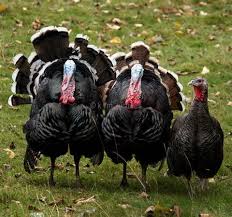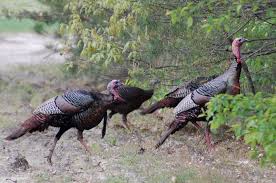The wild turkey is an upland ground bird native to North America and is the heaviest member of the diverse
Galliformes. It is the same species as the domestic turkey, which was originally derived from a southern
Mexican subspecies of wild turkey (not the related ocellated turkey). Although native to North America, the
turkey probably got its name from the domesticated variety being imported to Britain in ships coming from
the Levant via Spain. The British at the time therefore associated the wild turkey with the country Turkey
and the name prevails.
Description

Adult wild turkeys have long reddish-yellow to grayish-green legs. The body feathers are generally blackish
and dark, sometimes grey brown overall with a coppery sheen that becomes more complex in adult males. Adult
males, called toms or gobblers, have a large, featherless, reddish head, red throat, and red wattles on the
throat and neck. The head has fleshy growths called caruncles. Juvenile males are called jakes; the
difference between an adult male and a juvenile is that the jake has a very short beard and his tail fan has
longer feathers in the middle. The adult male's tail fan feathers will be all the same length. When males are
excited, a fleshy flap on the bill expands, and this, the wattles and the bare skin of the head and neck all
become engorged with blood, almost concealing the eyes and bill. The long fleshy object over a male's beak
is called a snood. Each foot has three toes in front, with a shorter, rear-facing toe in back; males have a
spur behind each of their lower legs.

Male turkeys have a long, dark, fan-shaped tail and glossy bronze wings. As with many other species of the
Galliformes, turkeys exhibit strong sexual dimorphism. The male is substantially larger than the female, and
his feathers have areas of red, purple, green, copper, bronze, and gold iridescence. Females, called hens,
have feathers that are duller overall, in shades of brown and gray. Parasites can dull coloration of both
sexes; in males, coloration may serve as a signal of health. The primary wing feathers have white bars.
Turkeys have 5000 to 6000 feathers. Tail feathers are of the same length in adults, different lengths in
juveniles. Males typically have a "beard", a tuft of coarse hair (modified feathers) growing from the center
of the breast. Beards average 230 mm (9.1 in) in length. In some populations, 10 to 20% of females have a
beard, usually shorter and thinner than that of the male. The adult male (or "tom") normally weighs from 5
to 11 kg (11 to 24 lb) and measures 100-125 cm (39-49 in) in length. The adult female (or "hen") is typically
much smaller at 2.5-5.4 kg (5.5-11.9 lb) and is 76 to 95 cm (30 to 37 in) long. Per two large studies, the
average weight of adult males is 7.6 kg (17 lb) and the average weight of adult females is 4.26 kg
(9.4 lb). The wings are relatively small, as is typical of the galliform order, and the wingspan ranges
from 1.25 to 1.44 m (4 ft 1 in to 4 ft 9 in). The wing chord is only 20 to 21.4 cm (7.9 to 8.4 in). The
bill is also relatively small, as adults measure 2 to 3.2 cm (0.79 to 1.26 in) in culmen length. The tarsus
of the wild turkey is quite long and sturdy, measuring from 9.7 to 19.1 cm (3.8 to 7.5 in). The tail is also
relatively long, ranging from 24.5 to 50.5 cm (9.6 to 19.9 in). The record-sized adult male wild turkey,
according to the National Wild Turkey Federation, weighed 16.85 kg (37.1 lb), with records of tom turkeys
weighing over 13.8 kg (30 lb) uncommon but not rare. While it is usually rather lighter than the waterfowl,
after the trumpeter swan (Cygnus buccinator), the turkey has the second heaviest maximum weight of any North
American bird. Going on average mass, several other birds on the continent, including the American white
pelican (Pelecanus erythrorhynchos), the tundra swan (Cygnus columbianus columbianus) and the very rare
California condor (Gymnogyps californianus) and whooping crane (Grus americana) surpass the mean weight of
turkeys. On one hand, none of these other species are as sexually dimorphic in size as the wild turkey, but
on the other, they are also far less numerous and are not legally hunted unlike the turkey, thousands of
which are weighed every year during hunting season.
Habitat

Wild turkeys prefer hardwood and mixed conifer-hardwood forests with scattered openings such as pastures,
fields, orchards and seasonal marshes. They seemingly can adapt to virtually any dense native plant
community as long as coverage and openings are widely available. Open, mature forest with a variety of
interspersion of tree species appear to be preferred. In the Northeast of North America, turkeys are most
profuse in hardwood timber of oak-hickory (Quercus-Carya) and forests of red oak (Quercus rubra), beech
(Fagus grandifolia), cherry (Prunus serotina) and white ash (Fraxinus americana). Best ranges for turkeys in
the Coastal Plain and Piedmont sections have an interspersion of clearings, farms, and plantations with
preferred habitat along principal rivers and in cypress (Taxodium distichum) and tupelo (Nyssa sylvatica)
swamps. Appalachian and Cumberland plateaus, birds occupy mixed forest of oaks and pines on southern and
western slopes, also hickory with diverse understories. Bald cypress and sweet gum (Liquidambar styraciflua)
swamps of s. Florida; also hardwood of Cliftonia (a heath) and oak in north-central Florida. Lykes
Fisheating Creek area of s. Florida has up to 51% cypress, 12% hardwood hammocks, 17% glades of short
grasses with isolated live oak (Quercus virginiana); nesting in neighboring prairies. Original habitat here
was mainly longleaf pine (Pinus palustris) with turkey oak (Quercus laevis) and slash pine (Pinus caribaea)
"flatwoods," now mainly replaced by slash pine plantations.
Behavior
Males are polygamous, mating with as many hens as they can. Male wild turkeys display for females by puffing
out their feathers, spreading out their tails and dragging their wings. This behavior is most commonly
referred to as strutting. Their heads and necks are colored brilliantly with red, blue and white. The color
can change with the turkey's mood, with a solid white head and neck being the most excited. They use
gobbling, drumming/booming and spitting as signs of social dominance, and to attract females. Courtship
begins during the months of March and April, which is when turkeys are still flocked together in winter
areas.
Males may be seen courting in groups, often with the dominant male gobbling, spreading their tail feathers
(strutting), drumming/booming and spitting. In a study, the average dominant male that courted as part of a
pair of males fathered six more eggs than males that courted alone. Genetic analysis of pairs of males
courting together shows that they are close relatives, with half of their genetic material being identical.
The theory behind the team-courtship is that the less dominant male would have a greater chance of passing
along shared genetic material than if it were courting alone.
When mating is finished, females search for nest sites. Nests are shallow dirt depressions engulfed with
woody vegetation. Hens lay a clutch of 10-14 eggs, usually one per day. The eggs are incubated for at least
28 days. The poults are precocial and nidifugous, leaving the nest in about 12-24 hours.
Range
The wild turkey in the United States in 1957 ranged from Arizona to southeastern Oklahoma and thence through
Tennessee, West Virginia, and New York, and south to Florida and Texas. It formerly ranged north to southeastern South Dakota,
southern Wisconsin, southern Ontario, and southwestern Maine. The A.O.U. Checklist also described Upper Pliocene fossils in
Kansas, and Pleistocene fossils widely from New Mexico to Pennsylvania and Florida. The Californian turkey, Meleagris
californica, is an extinct species of turkey indigenous to the Pleistocene and early Holocene of California. It became extinct
about 10,000 years ago. The present Californian wild turkey population derives from wild birds re-introduced during the 1960s and
70s from other areas by game officials.[48] They proliferated after 2000 to become an everyday sight in the East Bay Area by 2015.
At the beginning of the 20th century the range and numbers of wild turkeys had decreased due to hunting and loss of habitat. Game
managers estimate that the entire population of wild turkeys in the United States was as low as 30,000 in the early 20th century.
By the 1940s, it was almost totally extirpated from Canada and had become localized in pockets in the United States, in the
north-east effectively restricted to the Appalachians, only as far north as central Pennsylvania. Game officials made efforts to
protect and encourage the breeding of the surviving wild population, and some trapped birds were relocated to new areas, including
some in the western states where it was not native. There is evidence that the bird does well when near farmland, which provides
grain and also berry-bearing shrubs at its edges.[50] As wild turkey numbers rebounded, hunting became legal in 49 U.S. states
(excluding Alaska). In 1973, the total U.S. population was estimated to be 1.3 million, and current estimates place the entire
wild turkey population at 7 million individuals. In recent years, "trap and transfer" projects have reintroduced wild turkeys to
several provinces of Canada as well, sometimes from across the border in the United States.
Attempts to introduce the wild turkey to Britain as a game bird in the 18th century were not successful. George II is said to have
had a flock of a few thousand in Richmond Park near London, but they were too easy for local poachers to destroy, and the fights
with poachers became too dangerous for the gamekeepers. They were hunted with dogs and then shot out of trees where they took
refuge. Several other populations, introduced or escaped, have survived for periods elsewhere in Britain and Ireland, but seem to
have eventually died out, perhaps from a combination of lack of winter feed and poaching. Small populations, probably descended
from farm as well as wild stock, in the Czech Republic and Germany have been more successful, and there are wild populations of
some size following introductions in Hawaii and New Zealand.








